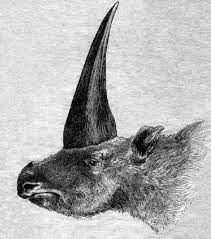With a huge horn rising several feet from the top of their skulls, it is easy to see how their fossilised remains could have been mistaken for the skeletons of the now mythical unicorns.
But it seems a giant species of rhinoceros, thought to have died out in Siberia 350,000 years ago may have actually clung on long enough to really enter into human legend.
Scientists claim to have discovered evidence the giant Elasmotherium sibiricum, or Siberian Unicorn as it is known locally, may have survived until 26,000 years ago.
This last place in south western Siberia could have allowed the strange creatures, which would have grown to the size of mammoths weighing up to five tons, to have encountered humans.
Early humans began spreading across Asia more than 50,000 years ago and probably moved into Siberia at least 35,000 years ago
Dr Andrei Shpanski, a palaeontologist, who led the new research, said: ‘Most likely, the south of Western Siberia was a refúgium, where this rhino persevered the longest in comparison with the rest of its range.
‘There is another possibility that it could migrate and dwell for a while in the more southern areas.’
The researchers discovered fragments of the giant rhinoceros skull.
It was discovered alongside the remains of prehistoric bioson and mammoth remains.
While Elasmotherium sibircum is thought to have spread widely across Siberia after it emerged around 2.6 million years ago, evidence suggests the majority of the species died out 350,000 years ago.
Fossilislied remains suggest it would have reached around 15ft long (4.6 meters) and stood over 6ft tall (2 meters), making it one of the largest species of rhino to have ever lived.
Although no horns from the animals have been found, studies of the skulls show a bony lump that is thought to have supported a keratin horn much like those seen on modern rhinos in Africa.
Research on the skulls have suggested the horns could have grown to have a circumference of more than three feet and would have been several feet long.
It is thought the animals may have used these enormous horns to drive away competitors and even sweeping snow from the grass in winter.
It also had long legs, which would have allowed the animal to gallop much like a horse rather than the lumbering trot seen in modern rhinos. They discovered it was between 26,038 years old – making it remarkably young.
The skull was well preserved and while it bore some cracks, it showed no sign of gnawing of abrasion.
Dr Shpanski said: ‘Most likely, it was a very large male of very large individual age.
He added that it is likely that as the climate in Siberia changed, causing many Elasmotherium sibircum to die out, local conditions may have allowed them to survive. It is not the first time scientists have discovered a last refuge of a giant ice age species thought to have died out long ago.
Woolly mammoths, which are widely thought to have died out 12,000 years ago may have survived until around 4,500 years ago.
Dr Shpanski said: ‘Our research makes adjustments in the understanding of the environmental conditions in the geologic time in general. ‘Understanding of the past allows us to make more accurate predictions about natural processes in the near future – it also concerns climate change.
Source :Daily mail
N.H.Kh

